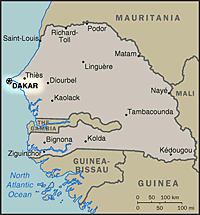|
.
|
|

Today, President Clinton visits Senegal, the last country in his trip
through Africa. Major events of his day include:
Bilateral Meeting and Reception with President Diouf
ACRI Training Exercises Visit
Dal Diam Village Visit
Bilateral Meeting and Reception with President Diouf
President Clinton meets with Senegalese President Diouf at the Presidential
Palace. The Presidential Palace was completed in 1907 and served as the
residence of the governors of French West Africa until April 1960, just
after Senegal's independence. Since that time, the Palace has served
successively as the official residence and offices of Presidents Leopold
Sedar Senghor and Abdou Diouf.
The outside of the Palace is a tourist site for visitors to Dakar, much
like the White House; however, public tours of the inside of the Palace are
not conducted. Unlike in many other African countries, visitors are
encouraged to photograph the Palace and the strikingly attired presidential
guards. The interior retains its original French flair, but is decorated
with Senegalese art, most notably tapestries.
ACRI Training Exercises Visit
President Clinton visits the Thies [CHESS] Military Base to observe U.S.
Army Special Forces troops conducting peacekeeping and humanitarian relief
training exercises with select Senegalese troops as part of the African
Crisis Response Initiative (ACRI). He will also review a group of
Senegalese troops, including "gendarmes," who served as peacekeepers in
Haiti and Bosnia. After observing the exercises, the President will deliver
brief remarks to the assembled troops honoring their efforts and
recognizing Senegal's commitment to peacekeeping worldwide.
The Thies Military base, formerly a French military facility, now serves as
the primary training ground for the Senegalese military. It houses
Senegal's military academy and infantry school, and is home to a commando
and medical unit.
Senegal was one of the first African nations to embrace ACRI. Along with
Uganda, Senegal also hosted the first ACRI training, in August and
September of 1997. Senegal has participated with professional distinction
in peacekeeping operations since the Katanga secession from the Congo in
1963. Its experience now includes Bosnia, Haiti, Liberia, Rwanda, the
Sinai and Lebanon. It was the first sub-Saharan African country to offer
troops to Operation Desert Shield/Storm.
Dal Diam Village Visit
President Clinton visits the village of Dal Diam [doll-DJAAM] is 20
kilometers north of Thies and 50 kilometers east of Dakar on the road to
St. Louis, Senegal's second largest city. Dal Diam, which has struggled for
survival for two decades, is a typical small village in rural Senegal, with
a population of approximately 250. The already difficult life of the
villagers -- mostly subsistence farmers -- has become even more challenging
due to severe drought, soil erosion, lack of credit and inadequate health
and educational services. In the past, limited opportunities forced
village men and youth to cities in search of work. The people of Dal Diam
are special, however, because they have reversed this trend.
In 1993, a group of village women joined in a USAID-funded integrated rural
development project run by the National Council of Negro Women (NCNW).
NCNW is a Washington, D.C.-based, non-profit organization, founded in 1935
by Mary McCloud Bethune and currently headed by Dr. Dorothy Height. Its
mission is to help women improve personal and family quality of life. From
1993-96, the NCNW provided approximately $230,000 in training, equipment
and material with the help of Tostan, a Senegal-based non-governmental
organization and the Rodale Institute, an environmental non-governmental
organization based in Pennsylvania.
With this assistance, the villagers of Dal Diam increased their access to
drinking water with a new well; established a health center; constructed
latrines; launched gardening and livestock-raising enterprises; provided
literacy training for adults and children; set up a cooperative village
store; introduced a micro-enterprise savings and credit system; and
initiated a variety of efforts to reverse environmental degradation. With
new educational and economic opportunities in the village, the exodus from
Dal Diam has been reversed.
Dal Diam represents grassroots civil society at its best. Building on the
skills and knowledge gained through NCNW's program, village women have
expanded into new areas, such as establishing their own savings and credit
program.
All of the unique aspects that make Dal Diam an example of sustainable
development will be highlighted in the Senegalese tradition of a "skit"
which will demonstrate aspects of rural governance, decentralization and
grassroots democracy.
|

![]()

![]()